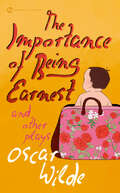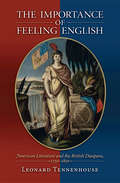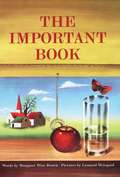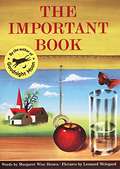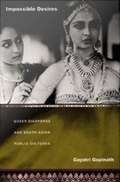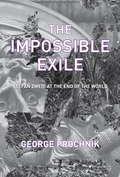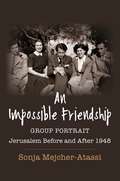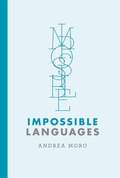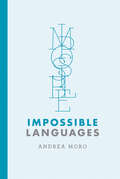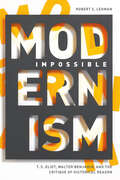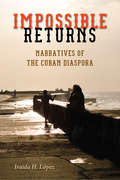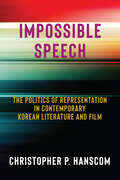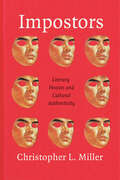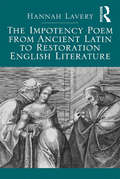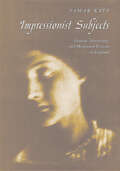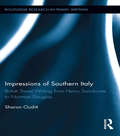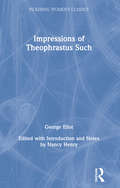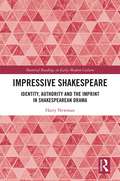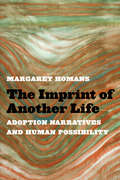- Table View
- List View
The Importance of Being Earnest and Other Plays
by Oscar WildeA universal favorite, The Importance of Being Earnest displays Oscar Wilde&’s wit and theatrical genius at their brilliant best. Subtitled &“A Trivial Comedy for Serious People,&” this hilarious attack on Victorian manners and morals turns a pompous world on its head, lets duplicity lead to happiness, and makes riposte the highest form of art. Written, according to Wilde, &“by a butterfly for butterflies,&” it is a dazzling masterpiece of comic entertainment.Although it was originally written in four acts, The Importance of Being Earnest is usually performed in a three-act version. This authoritative edition features an appendix that restores valuable lines that appeared in the original.Also included in this special collection are Wilde&’s first comedy success, Lady Windermere&’s Fan, and his richly sensual melodrama, Salomé, which he called &“that terrible coloured little tragedy I once in some strange mood wrote&”—and which shocked and enraged the censors of his time.Includes an Introduction by Sylvan Barnetand an Afterword by Elise Bruhl and Michael Gamer
The Importance of Feeling English: American Literature and the British Diaspora, 1750-1850
by Leonard TennenhouseAmerican literature is typically seen as something that inspired its own conception and that sprang into being as a cultural offshoot of America's desire for national identity. But what of the vast precedent established by English literature, which was a major American import between 1750 and 1850? In The Importance of Feeling English, Leonard Tennenhouse revisits the landscape of early American literature and radically revises its features. Using the concept of transatlantic circulation, he shows how some of the first American authors--from poets such as Timothy Dwight and Philip Freneau to novelists like William Hill Brown and Charles Brockden Brown--applied their newfound perspective to pre-existing British literary models. These American "re-writings" would in turn inspire native British authors such as Jane Austen and Horace Walpole to reconsider their own ideas of subject, household, and nation. The enduring nature of these literary exchanges dramatically recasts early American literature as a literature of diaspora, Tennenhouse argues--and what made the settlers' writings distinctly and indelibly American was precisely their insistence on reproducing Englishness, on making English identity portable and adaptable. Written in an incisive and illuminating style, The Importance of Feeling English reveals the complex roots of American literature, and shows how its transatlantic movement aided and abetted the modernization of Anglophone culture at large.
The Important Book
by Margaret Wise BrownThe important thing about The Important Book -- is that you let your child tell you what is important about the sun and the moon and the wind and the rain and a bug and a bee and a chair and a table and a pencil and a bear and a rainbow and a cat (if he wants to). For the important thing about The Important Book is that the book goes on long after it is closed. What is most important about many familiar things -- like rain and wind, apples and daisies -- is suggested in rhythmic words and vivid pictures. 'A perfect book . . . the text establishes a word game which tiny children will accept with glee.' -- K.
The Important Book (Into Reading, Read Aloud Module 2 #1)
by Leonard Weisgard Margaret BrownNIMAC-sourced textbook <p><p> Margaret Wise Brown, the New York Times bestselling author of the perennial classics Goodnight Moon and Runaway Bunny, asks children to think deeply about the importance of everyday objects, from apples to spoons. With lyrical words and vivid illustrations by Caldecott winner Leonard Weisgard, The Important Book shows children just how important everyday objects can be. <p> What is the most important thing about a spoon? The fact that you can eat with it? What about an apple? Or a shoe? This book helps curious preschoolers notice important details about their everyday surroundings, like daisies are white, rain is wet, and a spoon is used for eating.
The Impossible Craft: Literary Biography (Penn State Series in the History of the Book)
by Scott DonaldsonIn The Impossible Craft, Scott Donaldson explores the rocky territory of literary biography, the most difficult that biographers try to navigate. Writers are accustomed to controlling the narrative, and notoriously opposed to allowing intruders on their turf. They make bonfires of their papers, encourage others to destroy correspondence, write their own autobiographies, and appoint family or friends to protect their reputations as official biographers. Thomas Hardy went so far as to compose his own life story to be published after his death, while falsely assigning authorship to his widow. After a brief background sketch of the history of biography from Greco-Roman times to the present, Donaldson recounts his experiences in writing biographies of a broad range of twentieth-century American writers: Ernest Hemingway, F. Scott Fitzgerald, John Cheever, Archibald MacLeish, Edwin Arlington Robinson, Winfield Townley Scott, and Charlie Fenton. Donaldson provides readers with a highly readable insiders’ introduction to literary biography. He suggests how to conduct interviews, and what not to do during the process. He offers sound advice about how closely biographers should identify with their subjects. He examines the ethical obligations of the biographer, who must aim for the truth without unduly or unnecessarily causing discomfort or worse to survivors. He shows us why and how misinformation comes into existence and tends to persist over time. He describes “the mythical ideal biographer,” an imaginary creature of universal intelligence and myriad talents beyond the reach of any single human being. And he suggests how its very impossibility makes the goal of writing a biography that captures the personality of an author a challenge well worth pursuing.
The Impossible Craft: Literary Biography (Penn State Series in the History of the Book)
by Scott DonaldsonIn The Impossible Craft, Scott Donaldson explores the rocky territory of literary biography, the most difficult that biographers try to navigate. Writers are accustomed to controlling the narrative, and notoriously opposed to allowing intruders on their turf. They make bonfires of their papers, encourage others to destroy correspondence, write their own autobiographies, and appoint family or friends to protect their reputations as official biographers. Thomas Hardy went so far as to compose his own life story to be published after his death, while falsely assigning authorship to his widow. After a brief background sketch of the history of biography from Greco-Roman times to the present, Donaldson recounts his experiences in writing biographies of a broad range of twentieth-century American writers: Ernest Hemingway, F. Scott Fitzgerald, John Cheever, Archibald MacLeish, Edwin Arlington Robinson, Winfield Townley Scott, and Charlie Fenton. Donaldson provides readers with a highly readable insiders’ introduction to literary biography. He suggests how to conduct interviews, and what not to do during the process. He offers sound advice about how closely biographers should identify with their subjects. He examines the ethical obligations of the biographer, who must aim for the truth without unduly or unnecessarily causing discomfort or worse to survivors. He shows us why and how misinformation comes into existence and tends to persist over time. He describes “the mythical ideal biographer,” an imaginary creature of universal intelligence and myriad talents beyond the reach of any single human being. And he suggests how its very impossibility makes the goal of writing a biography that captures the personality of an author a challenge well worth pursuing.
Impossible Desires: Queer Diasporas and South Asian Public Cultures
by Gayatri GopinathBy bringing queer theory to bear on ideas of diaspora, Gayatri Gopinath produces both a more compelling queer theory and a more nuanced understanding of diaspora. Focusing on queer female diasporic subjectivity, Gopinath develops a theory of diaspora apart from the logic of blood, authenticity, and patrilineal descent that she argues invariably forms the core of conventional formulations. She examines South Asian diasporic literature, film, and music in order to suggest alternative ways of conceptualizing community and collectivity across disparate geographic locations. Her agile readings challenge nationalist ideologies by bringing to light that which has been rendered illegible or impossible within diaspora: the impure, inauthentic, and nonreproductive. Gopinath juxtaposes diverse texts to indicate the range of oppositional practices, subjectivities, and visions of collectivity that fall outside not only mainstream narratives of diaspora, colonialism, and nationalism but also most projects of liberal feminism and gay and lesbian politics and theory. She considers British Asian music of the 1990s alongside alternative media and cultural practices. Among the fictional works she discusses are V. S. Naipaul's classic novel A House for Mr. Biswas, Ismat Chughtai's short story "The Quilt," Monica Ali's Brick Lane, Shyam Selvadurai's Funny Boy, and Shani Mootoo's Cereus Blooms at Night. Analyzing films including Deepa Mehta's controversial Fire and Mira Nair's Monsoon Wedding, she pays particular attention to how South Asian diasporic feminist filmmakers have reworked Bollywood's strategies of queer representation and to what is lost or gained in this process of translation. Gopinath's readings are dazzling, and her theoretical framework transformative and far-reaching.
The Impossible Exile
by George ProchnikAn original study of exile, told through the biography of Austrian writer Stefan Zweig By the 1930s, Stefan Zweig had become the most widely translated living author in the world. His novels, short stories, and biographies were so compelling that they became instant best sellers. Zweig was also an intellectual and a lover of all the arts, high and low. Yet after Hitler's rise to power, this celebrated writer who had dedicated so much energy to promoting international humanism plummeted, in a matter of a few years, into an increasingly isolated exile--from London to Bath to New York City, then Ossining, Rio, and finally Petrópolis--where, in 1942, in a cramped bungalow, he killed himself. The Impossible Exile tells the tragic story of Zweig's extraordinary rise and fall while it also depicts, with great acumen, the gulf between the world of ideas in Europe and in America, and the consuming struggle of those forced to forsake one for the other. It also reveals how Zweig embodied, through his work, thoughts, and behavior, the end of an era--the implosion of Europe as an ideal of Western civilization.
An Impossible Friendship: Group Portrait, Jerusalem Before and After 1948 (Religion, Culture, and Public Life #47)
by Sonja Mejcher-AtassiIn Jerusalem, as World War II was coming to an end, an extraordinary circle of friends began to meet at the bar of the King David Hotel. This group of aspiring artists, writers, and intellectuals—among them Wolfgang Hildesheimer, Jabra Ibrahim Jabra, Sally Kassab, Walid Khalidi, and Rasha Salam, some of whom would go on to become acclaimed authors, scholars, and critics—came together across religious lines in a fleeting moment of possibility within a troubled history. What brought these Muslim, Jewish, and Christian friends together, and what became of them in the aftermath of 1948, the year of the creation of the State of Israel and the Palestinian Nakba?Sonja Mejcher-Atassi tells the story of this unlikely friendship and in so doing offers an intimate cultural and social history of Palestine in the critical postwar period. She vividly reconstructs the vanished social world of these protagonists, tracing the connections between the specificity of individual lives and the larger contexts in which they are embedded. In exploring this ecumenical friendship and its artistic, literary, and intellectual legacies, Mejcher-Atassi demonstrates how social biography can provide a picture of the past that is at once more inclusive and more personal. This group portrait, she argues, allows us to glimpse alternative possibilities that exist within and alongside the fraught history of Israel/Palestine. Bringing a remarkable era to life through archival research and nuanced interdisciplinary scholarship, An Impossible Friendship unearths prospects for historical reconciliation, solidarity, and justice.
The Impossible H. L. Mencken: A Selection of His Best Newspaper Stories
by H. L. MenckenA collection of newspaper articles written by Mencken over the course of his long and distinguished career.
Impossible Joyce
by Patrick O'NeillJames Joyce's Finnegans Wake has repeatedly been declared to be entirely untranslatable. Nonetheless, it has been translated, transposed, or transcreated into a surprising variety of languages - including complete renditions in French, German, Portuguese, Dutch, Japanese, and Korean, and partial renditions in Italian, Spanish, and a variety of other languages. Impossible Joyce explores the fascinating range of different approaches adopted by translators in coming to grips with Joyce's astonishing literary text.In this study, Patrick O'Neill builds on an approach first developed in his book Polyglot Joyce, but deepens his focus by considering Finnegans Wake exclusively. Venturing from Umberto Eco's assertion that the novel is a machine designed to generate as many meanings as possible for readers, he provides a sustained examination of the textual effects generated by comparative readings of translated excerpts. In doing so, O'Neill makes manifest the ways in which attempts to translate this extraordinary text have resulted in a cumulative extension of Finnegans Wake into an even more extraordinary macrotext encompassing and subsuming its collective renderings.
Impossible Languages
by Andrea MoroCan there be such a thing as an impossible human language? A biologist could describe an impossible animal as one that goes against the physical laws of nature (entropy, for example, or gravity). Are there any such laws that constrain languages? In this book, Andrea Moro -- a distinguished linguist and neuroscientist -- investigates the possibility of impossible languages, searching, as he does so, for the indelible "fingerprint" of human language.Moro shows how the very notion of impossible languages has helped shape research on the ultimate aim of linguistics: to define the class of possible human languages. He takes us beyond the boundaries of Babel, to the set of properties that, despite appearances, all languages share, and explores the sources of that order, drawing on scientific experiments he himself helped design. Moro compares syntax to the reverse side of a tapestry revealing a hidden and apparently intricate structure. He describes the brain as a sieve, considers the reality of (linguistic) trees, and listens for the sound of thought by recording electrical activity in the brain. Words and sentences, he tells us, are like symphonies and constellations: they have no content of their own; they exist because we listen to them and look at them. We are part of the data.
Impossible Languages: The Brain And The Enigma Of Impossible Languages (The\mit Press Ser. #46)
by Andrea MoroAn investigation into the possibility of impossible languages, searching for the indelible “fingerprint” of human language.Can there be such a thing as an impossible human language? A biologist could describe an impossible animal as one that goes against the physical laws of nature (entropy, for example, or gravity). Are there any such laws that constrain languages? In this book, Andrea Moro—a distinguished linguist and neuroscientist—investigates the possibility of impossible languages, searching, as he does so, for the indelible “fingerprint” of human language.Moro shows how the very notion of impossible languages has helped shape research on the ultimate aim of linguistics: to define the class of possible human languages. He takes us beyond the boundaries of Babel, to the set of properties that, despite appearances, all languages share, and explores the sources of that order, drawing on scientific experiments he himself helped design. Moro compares syntax to the reverse side of a tapestry revealing a hidden and apparently intricate structure. He describes the brain as a sieve, considers the reality of (linguistic) trees, and listens for the sound of thought by recording electrical activity in the brain. Words and sentences, he tells us, are like symphonies and constellations: they have no content of their own; they exist because we listen to them and look at them. We are part of the data.
Impossible Modernism: T. S. Eliot, Walter Benjamin, and the Critique of Historical Reason
by Robert LehmanImpossible Modernism reads the writings of German philosopher and critic Walter Benjamin (1892-1940) and Anglo-American poet and critic T. S. Eliot (1888-1965) to examine the relationship between literary and historical form during the modernist period. It focuses particularly on how they both resisted the forms of narration established by nineteenth-century academic historians and turned instead to traditional literary devices--lyric, satire, anecdote, and allegory--to reimagine the forms that historical representation might take. Tracing the fraught relationship between poetry and history back to Aristotle's Poetics and forward to Nietzsche's Untimely Meditations, Robert S. Lehman establishes the coordinates of the intellectual-historical problem that Eliot and Benjamin inherited and offers an analysis of how they grappled with this legacy in their major works.
Impossible Owls: Essays from the Ends of the World
by Brian PhillipsNEW YORK TIMES BESTSELLER'Hilarious, nimble, and thoroughly illuminating' Colson Whitehead, author of The Underground Railroad'Recalls the work of John Jeremiah Sullivan and the late David Foster Wallace, with a dash of Janet Malcolm' VogueFrom its opening journey into remote Alaska for the Iditarod Sled Dog Race, IMPOSSIBLE OWLS leads us on a kaleidoscopic exploration of contemporary reality. Brian Phillips takes us to a sumo tournament in Japan, the jungle in India, the studio of a great Russian animator, a royal tour of the Yukon Territory with the Duke and Duchess of Cambridge and into the weird heart of America. This exhilarating debut visits borders both real and imagined, and asks what it means, in our age, to travel to the end of the map.
Impossible Returns: Narratives of the Cuban Diaspora
by Iraida LopezIn this one-of-a-kind volume, Iraida López explores various narratives of return by those who left Cuba as children or adolescents. Including memoirs, semi-autobiographical fiction, and visual arts, many of these accounts feature a physical arrival on the island while others depict a metaphorical or vicarious experience by means of fictional characters or childhood reminiscences. As two-way migration increases in the post-Cold War period, many of these narratives put to the test the boundaries of national identity. Through a critical reading of works by Cuban American artists and writers like María Brito, Ruth Behar, Carlos Eire, Cristina García, Ana Mendieta, Gustavo Pérez Firmat, Ernesto Pujol, Achy Obejas, and Ana Menéndez, López highlights the affective ties as well as the tensions underlying the relationship between returning subjects and their native country. Impossible Returns also looks at how Cubans still living on the island depict returning émigrés in their own narratives, addressing works by Jesús Díaz, Humberto Solás, Carlos Acosta, Nancy Alonso, Leonardo Padura, and others. Blurring the lines between disciplines and geographic borders, this book underscores the centrality of Cuba for its diaspora and bears implications for other countries with widespread populations in exile.
Impossible Speech: The Politics of Representation in Contemporary Korean Literature and Film
by Christopher HanscomIn what ways can or should art engage with its social context? Authors, readers, and critics have been preoccupied with this question since the dawn of modern literature in Korea. Advocates of social engagement have typically focused on realist texts, seeing such works as best suited to represent injustices and inequalities by describing them as if they were before our very eyes.Christopher P. Hanscom questions this understanding of political art by examining four figures central to recent Korean fiction, film, and public discourse: the migrant laborer, the witness to or survivor of state violence, the refugee, and the socially excluded urban precariat. Instead of making these marginalized figures intelligible to common sense, this book reveals the capacity of art to address the “impossible speech” of those who are not asked, expected, or allowed to put forward their thoughts, yet who in so doing expand the limits of the possible.Impossible Speech proposes a new approach to literature and film that foregrounds ostensibly “nonpolitical” or nonsensical moments, challenging assumptions about the relationship between politics and art that locate the “politics” of the work in the representation of content understood in advance as being political. Recasting the political as a struggle over the possibility or impossibility of speech itself, this book finds the politics of a work of art in its power to confront the boundaries of what is sayable.
Impostors: Literary Hoaxes and Cultural Authenticity
by Christopher L. Miller“Miller takes us on an exciting tour of postcolonial and world literature, guiding us through the literary maze of the real and the pretenders to the real.” —Ngugi wa Thiong’o, author of Wizard of the CrowWriting a new page in the surprisingly long history of literary deceit, Impostors examines a series of literary hoaxes, deceptions that involved flagrant acts of cultural appropriation. This book looks at authors who posed as people they were not, in order to claim a different ethnic, class, or other identity. These writers were, in other words, literary usurpers and appropriators who trafficked in what Christopher L. Miller terms the “intercultural hoax.”In the United States, such hoaxes are familiar. Forrest Carter’s The Education of Little Tree and JT LeRoy’s Sarah are two infamous examples. Miller’s contribution is to study hoaxes beyond our borders, employing a comparative framework and bringing French and African identity hoaxes into dialogue with some of their better-known American counterparts. In France, multiculturalism is generally eschewed in favor of universalism, and there should thus be no identities (in the American sense) to steal. However, as Miller demonstrates, this too is a ruse: French universalism can only go so far and do so much. There is plenty of otherness to appropriate. This French and Francophone tradition of imposture has never received the study it deserves. Taking a novel approach to this understudied tradition, Impostors examines hoaxes in both countries, finding similar practices of deception and questions of harm. “In this fascinating study of intercultural literary hoaxes, Christopher L. Miller provides a useful, brief history of American literary impostures as a backdrop for his investigation of France’s literary history of ‘ethnic usurpation.’” —Henry Louis Gates, Jr., New York Times–bestselling author
The Impotency Poem from Ancient Latin to Restoration English Literature
by Hannah LaveryThe first book length study of the motif of impotency in poetry from early antiquity through to the late Restoration, this book explores the impotency poem as a recognisable form of poetry in the longer tradition of erotic elegy. Hannah Lavery’s central claim is that the impotency motif is adopted by poets in recognition of its potential to signify satirically through its use as symbol and allegory. By drawing together analysis of works in the tradition, Lavery shows how the impotency motif is used to engage with anxieties as to what it means to enact ’service’ within political and social contexts. She demonstrates that impotency poems can be seen on one level to represent bawdy escapism, but on the other to offer positions of resistance and opposition to social and political concerns contemporary to a particular time. Whilst the link between the 'Imperfect Enjoyment' poems by Ovid and Rochester is well known, Lavery here looks further back to the origins of the concept of male impotency as degradation in the works of earlier Roman poets. This is an important context for considering how the impotency poem then first appears in the French and English vernaculars during the sixteenth century, leading to translations and adaptations throughout the seventeenth century. Lavery's close readings of the poems consider both the nature of the literary form, and the political and social contexts within which the works appear, in order to chart the intertextual development of the impotency poem as a distinct form of writing in the early modern period.
Impressionist Subjects: Gender, Interiority, and Modernist Fiction in England
by Tamar KatzExploring the intersection of ideas about woman, subjectivity, and literary authority, Impressionist Subjects reveals the female subject as crucial in framing contradictions central to modernism, particularly the tension between modernism's claim to timeless art and its critique of historical conditions. Against the backdrop of the New Woman movement of the 1890s, Tamar Katz establishes literary impressionism as integral to modernist form and to the modernist project of investigating the nature and function of subjectivity. Focusing on a duality common to impressionism and contemporary ideas of feminine subjectivity, Katz shows how the New Woman reconciled the paradox of a subject at once immersed in the world and securely enclosed in a mysterious interiority. Book chapters feature discussion of modernists including Walter Pater, George Egerton, Sarah Grand, Henry James, Joseph Conrad, Ford Madox Ford, Dorothy Richardson, and Virginia Woolf. Sophisticated and tightly argued, Impressionist Subjects is a substantial contribution to the reassessment and expansion of the modernist fiction canon.
Impressions of Southern Italy: British Travel Writing from Henry Swinburne to Norman Douglas (Routledge Research in Travel Writing)
by Sharon OudittNaples was conventionally the southernmost stop of the Grand Tour beyond which, it was assumed, lay violent disorder: earthquakes, malaria, bandits, inhospitable inns, few roads and appalling food. On the other hand, Southern Italy lay at the heart of Magna Graecia, whose legends were hard-wired into the cultural imaginations of the educated. This book studies the British travellers who visited Italy's Southern territories. Spanning the late eighteenth century to the mid-twentieth century, the author considers what these travellers discovered, not in the form of a survey, but as a series of unfolding impressions disclosing multiple Southern Italies. Of the numerous travellers analysed within this volume, the central figures are Henry Swinburne, Craufurd Tait Ramage and Norman Douglas, whose Old Calabria (1915) remains in print. Their appeal is that they take the region seriously: Southern Italy wasn't simply a testing ground for their superior sensibilities, it was a vibrant curiosity, unknown but within reach. Was the South simply behind on the road to European integration; or was it beyond a fault line, representing a viable alternative to Northern neuroses? The travelogues analysed in this book address a wide variety of themes which continue to shape discussions about European identity today.
Impressions of Theophrastus Such: Essays And Leaves From A Note-book (classic Reprint) (Pickering Women's Classics)
by George EliotGeorge Eliot (1819-80) is one of the most widely-read of the 19th-century novelists and story-writers. "Impressions of Theophrastus Such" appeared in 1879, Eliot's last completed work. It consists of 18 short essays narrated by a middle-aged bachelor, Theophrastus.
Impressive Shakespeare: Identity, Authority and the Imprint in Shakespearean Drama (Material Readings in Early Modern Culture)
by Harry NewmanImpressive Shakespeare reassesses Shakespeare’s relationship with "print culture" in light of his plays’ engagement with the language and material culture of three interrelated "impressing technologies": wax sealing, coining, and typographic printing. It analyses the material and rhetorical forms through which drama was thought to "imprint" early modern audiences and readers with ideas, morals and memories, and—looking to our own cultural moment—shows how Shakespeare has been historically constructed as an "impressive" dramatist. Through material readings of four plays—Coriolanus, A Midsummer Night’s Dream, Measure for Measure and The Winter’s Tale—Harry Newman argues that Shakespeare deploys the imprint as a self-reflexive trope in order to advertise the value of his plays to audiences and readers, and that in turn the language of impression has shaped, and continues to shape, Shakespeare’s critical afterlife. The book pushes the boundaries of what we understand by "print culture", and challenges assumptions about the emergence of concepts now central to Shakespeare’s perceived canonical value, such as penetrating characterisation, poetic transformation, and literary fatherhood.
The Imprint of Another Life: Adoption Narratives and Human Possibility
by Margaret HomansThe Imprint of Another Life: Adoption Narratives and Human Possibility addresses a series of questions about common beliefs about adoption. Underlying these beliefs is the assumption that human qualities are innate and intrinsic, an assumption often held by adoptees and their families, sometimes at great emotional cost. This book explores representations of adoption—transracial, transnational, and domestic same-race adoption—that reimagine human possibility by questioning this assumption and conceiving of alternatives. Literary scholar Margaret Homans examines fiction making’s special relationship to themes of adoption, an “as if” form of family making, fabricated or fictional instead of biological or “real. ” Adoption has tended to generate stories rather than uncover bedrock truths. Adoptive families are made, not born; in the words of novelist Jeanette Winterson, “adopted children are self-invented because we have to be. ” In attempting to recover their lost histories and identities, adoptees create new stories about themselves. While some believe that adoptees cannot be whole unless they reconnect with their origins, others believe that privileging biology reaffirms hierarchies (such as those of race) that harm societies and individuals. Adoption is lived and represented through an irresolvable tension between belief in the innate nature of human traits and belief in their constructedness, contingency, and changeability. The book shows some of the ways in which literary creation, and a concept of adoption as a form of creativity, manages this tension. The texts examined include fiction (e. g. , classic novels such as Silas Marner, What Maisie Knew, and Beloved); memoirs by adoptees, adoptive parents, and birthmothers; drama, documentary films, advice manuals, social science writing; and published interviews with adoptees, parents, and birth parents. Along the way the book tracks the quests of adoptees who, whether or not they meet their original families, must construct their own stories rather than finding them; follows transnational adoptees as they return, hopes held high, to Korea and China; looks over the shoulders of a generation of girls adopted from China as they watch Disney’s iconic Mulan, with its alluring story of destiny written on the skin; and listens to birthmothers as they struggle to tell painful secrets held for decades. This book engages in debates within adoption studies, women’s and gender studies, transnational studies, and ethnic studies; it will appeal to literary scholars and critics, including specialists in memoir or narrative theory, and to general readers interested in adoption and in race.
Imprints class 11 - Meghalaya Board
by Meghalaya Board of School EducationThe book Imprints is an Alternative English subject for Class XI, from Meghalaya Board. The book focuses on enabling the students to become independent readers, honing language skills such as listening, speaking, reading and writing, equipping students with the vocabulary required to function effectively in their professional lives, developing a taste for reading quality material, acquiring analytical and critical thinking and sharpening language skills to be able to cope with learning the other subjects. Lessons have been devised and prepared to take the students from the known to the unknown and to develop communication skills in the young learners preparing them to deal with day-to-day problems and enhance their life experiences.
